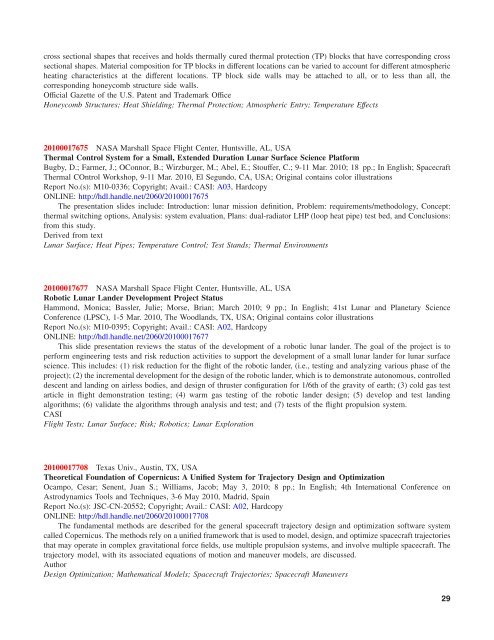NASA Scientific and Technical Aerospace Reports - The University ...
NASA Scientific and Technical Aerospace Reports - The University ...
NASA Scientific and Technical Aerospace Reports - The University ...
You also want an ePaper? Increase the reach of your titles
YUMPU automatically turns print PDFs into web optimized ePapers that Google loves.
cross sectional shapes that receives <strong>and</strong> holds thermally cured thermal protection (TP) blocks that have corresponding cross<br />
sectional shapes. Material composition for TP blocks in different locations can be varied to account for different atmospheric<br />
heating characteristics at the different locations. TP block side walls may be attached to all, or to less than all, the<br />
corresponding honeycomb structure side walls.<br />
Official Gazette of the U.S. Patent <strong>and</strong> Trademark Office<br />
Honeycomb Structures; Heat Shielding; <strong>The</strong>rmal Protection; Atmospheric Entry; Temperature Effects<br />
20100017675 <strong>NASA</strong> Marshall Space Flight Center, Huntsville, AL, USA<br />
<strong>The</strong>rmal Control System for a Small, Extended Duration Lunar Surface Science Platform<br />
Bugby, D.; Farmer, J.; OConnor, B.; Wirzburger, M.; Abel, E.; Stouffer, C.; 9-11 Mar. 2010; 18 pp.; In English; Spacecraft<br />
<strong>The</strong>rmal COntrol Workshop, 9-11 Mar. 2010, El Segundo, CA, USA; Original contains color illustrations<br />
Report No.(s): M10-0336; Copyright; Avail.: CASI: A03, Hardcopy<br />
ONLINE: http://hdl.h<strong>and</strong>le.net/2060/20100017675<br />
<strong>The</strong> presentation slides include: Introduction: lunar mission definition, Problem: requirements/methodology, Concept:<br />
thermal switching options, Analysis: system evaluation, Plans: dual-radiator LHP (loop heat pipe) test bed, <strong>and</strong> Conclusions:<br />
from this study.<br />
Derived from text<br />
Lunar Surface; Heat Pipes; Temperature Control; Test St<strong>and</strong>s; <strong>The</strong>rmal Environments<br />
20100017677 <strong>NASA</strong> Marshall Space Flight Center, Huntsville, AL, USA<br />
Robotic Lunar L<strong>and</strong>er Development Project Status<br />
Hammond, Monica; Bassler, Julie; Morse, Brian; March 2010; 9 pp.; In English; 41st Lunar <strong>and</strong> Planetary Science<br />
Conference (LPSC), 1-5 Mar. 2010, <strong>The</strong> Woodl<strong>and</strong>s, TX, USA; Original contains color illustrations<br />
Report No.(s): M10-0395; Copyright; Avail.: CASI: A02, Hardcopy<br />
ONLINE: http://hdl.h<strong>and</strong>le.net/2060/20100017677<br />
This slide presentation reviews the status of the development of a robotic lunar l<strong>and</strong>er. <strong>The</strong> goal of the project is to<br />
perform engineering tests <strong>and</strong> risk reduction activities to support the development of a small lunar l<strong>and</strong>er for lunar surface<br />
science. This includes: (1) risk reduction for the flight of the robotic l<strong>and</strong>er, (i.e., testing <strong>and</strong> analyzing various phase of the<br />
project); (2) the incremental development for the design of the robotic l<strong>and</strong>er, which is to demonstrate autonomous, controlled<br />
descent <strong>and</strong> l<strong>and</strong>ing on airless bodies, <strong>and</strong> design of thruster configuration for 1/6th of the gravity of earth; (3) cold gas test<br />
article in flight demonstration testing; (4) warm gas testing of the robotic l<strong>and</strong>er design; (5) develop <strong>and</strong> test l<strong>and</strong>ing<br />
algorithms; (6) validate the algorithms through analysis <strong>and</strong> test; <strong>and</strong> (7) tests of the flight propulsion system.<br />
CASI<br />
Flight Tests; Lunar Surface; Risk; Robotics; Lunar Exploration<br />
20100017708 Texas Univ., Austin, TX, USA<br />
<strong>The</strong>oretical Foundation of Copernicus: A Unified System for Trajectory Design <strong>and</strong> Optimization<br />
Ocampo, Cesar; Senent, Juan S.; Williams, Jacob; May 3, 2010; 8 pp.; In English; 4th International Conference on<br />
Astrodynamics Tools <strong>and</strong> Techniques, 3-6 May 2010, Madrid, Spain<br />
Report No.(s): JSC-CN-20552; Copyright; Avail.: CASI: A02, Hardcopy<br />
ONLINE: http://hdl.h<strong>and</strong>le.net/2060/20100017708<br />
<strong>The</strong> fundamental methods are described for the general spacecraft trajectory design <strong>and</strong> optimization software system<br />
called Copernicus. <strong>The</strong> methods rely on a unified framework that is used to model, design, <strong>and</strong> optimize spacecraft trajectories<br />
that may operate in complex gravitational force fields, use multiple propulsion systems, <strong>and</strong> involve multiple spacecraft. <strong>The</strong><br />
trajectory model, with its associated equations of motion <strong>and</strong> maneuver models, are discussed.<br />
Author<br />
Design Optimization; Mathematical Models; Spacecraft Trajectories; Spacecraft Maneuvers<br />
29

















